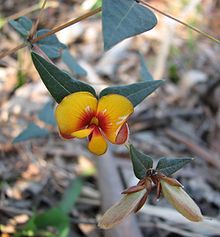- Platylobium obtusangulum
-
Common Flat-pea 
Scientific classification Kingdom: Plantae (unranked): Angiosperms (unranked): Eudicots (unranked): Rosids Order: Fabales Family: Fabaceae Subfamily: Faboideae Tribe: Bossiaeeae Genus: Platylobium Species: P. obtusangulum Binomial name Platylobium obtusangulum
Hook.Synonyms Platylobium macrocalyx Meisn.
Platylobium obtusangulum (Common Flat-pea) is a shrub which is endemic to Australia . It is a member of the family Fabaceae and of the genus Platylobium.
The species is an erect or straggling shrub that can grow up to 1 metre in height. The leaves are variable in shape and their length ranges from 1 to 3 cm.[1]
The flowers appear in spring. These are yellow with a red centre and are supported by short pedicels that are concealed by a series of overlapping bracts. The pods which follow are 14 to 25 mm in length and 10 to 14 mm in width.[1]
The species was first formally described by botanist William Jackson Hooker in 1833 in Botanical Magazine.[2] There are currently two recognised varieties:
- P. obtusangulum Hook. var. obtusangulum
- P. obtusangulum var. spinulosum J.H.Willis [2]
This species is found in South Australia, Tasmania, and Victoria.
References
- ^ a b Corrick, M.G. and Fuhrer, B.A. (2001). Wildflowers of Victoria and adjoining areas. Australia: Bloomings Books. ISBN 1876473142.
- ^ a b "Platylobium obtusangulum". Australian Plant Name Index (APNI), IBIS database. Centre for Plant Biodiversity Research, Australian Government, Canberra. http://www.anbg.gov.au/cgi-bin/apni?TAXON_NAME=PLATYLOBIUM+OBTUSANGULUM. Retrieved 2008-09-01.
Categories:- Fabales of Australia
- Faboideae
- Flora of South Australia
- Flora of Tasmania
- Flora of Victoria (Australia)
- Plants described in 1833
- Faboideae stubs
- Australian rosid stubs
Wikimedia Foundation. 2010.
